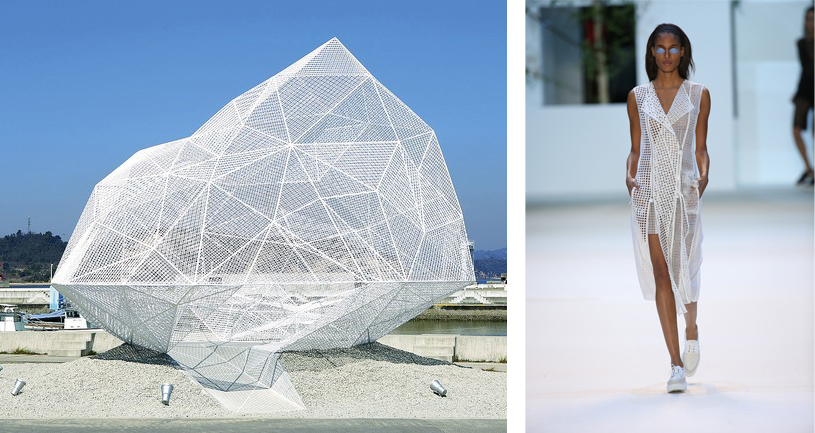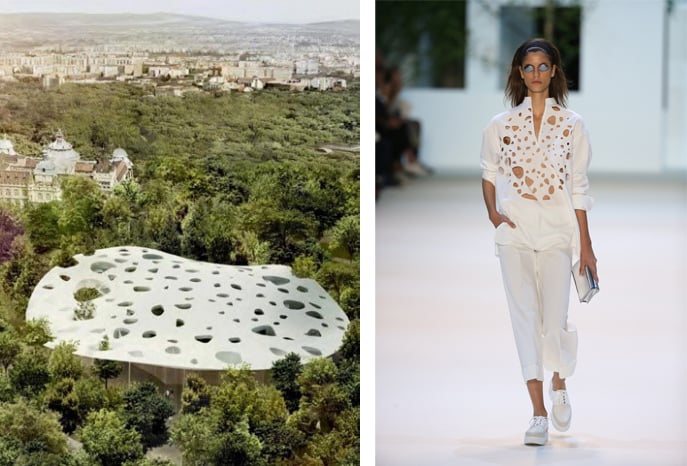Art World
See Albert Kriemler’s Sharp Designs and the World-Famous Architecture That Inspired Them
Kriemler was drawn to Sou Fujimoto's eco-friendly masterpieces.
Kriemler was drawn to Sou Fujimoto's eco-friendly masterpieces.
In Partnership With AKRIS

Albert Kriemler gave a new twist to the idea of “building a collection” when he began working on his minimalist designs for Akris’s Spring-Summer 2016 Collection.
A devotee of modernist architecture, Kriemler took inspiration from the airy buildings and structures—Zen-like in their serenity—created by Sou Fujimoto with their relationship to nature in mind. His first experience of the Japanese architect’s work was seeing his 2013 Serpentine Gallery Pavilion, a cloud of white steel poles arranged in an intricate grid and forming an ascending seating terrace amid London’s verdant Kensington Gardens.

Left: House N, Courtesy of YouTube.
Right: Delirio House N trees Parka and Tunic Dress, Courtesy of Akris.
Embarking on a collaboration with Fujimoto, Kriemler replicated the pavilion as a red design motif evoked by Fujimoto’s sketching the cloud in clustered red ink lines, which also suggested to him the red embroidery he used on pure white asymmetrical tunic, T-shirt and bag.
“In Sou’s work, I recognize a desire to comprehend and create volume, space and room, to intertwine nature and construction, to work with transparency and opaqueness that rings familiar to me,” Kriemler has said. “He is a great integrator and he is able to express a complex virtuosity with utmost simplicity and ease.”

Left: Serpentine Gallery Pavilion, Courtesy of Serpentine Galleries.
Right: White Tunic and Bag with Red Embroidery, Courtesy of Akris.
The two men first met in 2015 through the photographer Iwan Baan in Paris, where Fujimoto was working on the Ecole Polytechnique at the Université Paris-Saclay campus south of the city. The Polytechnique building, housing six schools, will feature unconfined walkways and balconies and be organized around a light-filled atrium adorned by trees and plants.
Fujimoto’s incorporating of nature into a working-socializing space—or living space in the case of his 2008 House N, a structure of three white nested shells in Kyushu island’s Ōita Prefecture—is mirrored in Kriemler’s prints on the flowing parka pared with a tunic dress presented as part of the collection at the Grand Palais in Paris last fall. The models in the show passed through a replica of House N that connected backstage with the runway at the Palais.

Left: Naoshima Pavilion, Courtesy of Architectural Record.
Right: Delaware Naoshima Pavilion embroidery coatdress, Courtesy of Akris.
Kriemler was greatly moved by Fujimoto’s delicate white pavilion in the harbor at Naoshima, his monumental “21st Century Oasis” design for the Taiwan Towers project, his upscale Palm Court retail complex in Miami’s Design District, and the huge white mushroom-shaped canopy—dotted with apertures to allow trees to grow through it—for the House of Hungarian Music in the museum complex planned for Budapest’s city park.
The Naoshima pavilion’s intricate diamond shape inspired Kriemler’s 3D-printed rings and its mesh panels prompted the broderie anglaise that characterized the cutting-edge ensembles in this group.

Left: Taiwan Center, Courtesy of Daily Mail.
Right: White Cotton Knight Top, Pullover and Skirt, Courtesy of Akris.
The Taiwan Towers gave Kriemler the idea for the bamboo-derived texture of an exquisitely diaphanous fabric used in some of the loveliest dresses; the sapphire-blue glass fins of the Palm Court’s façade influenced dresses and futuristic jackets in brilliant shades ranging from navy to marine. And the different shaped apertures intended to aerate the Hungarian music hall are represented in an archipelago of geometrically shaped cut-outs on the garments.
No single facet—whether cut, line, color, or fabric—is more important than any other in Kriemler’s breathtaking designs, yet what doesn’t meet the eye in them was clearly a defining element in their conception. The ellipses, holes, and abbreviations in many of the collection’s shift dresses (an Akris icon), in its shorts, pants, tops, shirts, and accessories, are as essential to their elegance as the sublime fabrics that surround such artfully contrived voids.

Left: Palm Court, Courtesy of Dezeen.
Right: Glass Vinyl Coat and Tulle Tunic, Courtesy of Akris.
These are clothes for cool, sexy modern women who exude self-possession and playfulness, hence the avoidance not only of frills and fuss but the absence of convention. Kriemler sees no reason why a hemline shouldn’t be two-tiered or a garment beautifully ventilated.
Sometimes Kriemler’s fabrics are gossamer-thin—a sensuous near-transparency complementing dresses or tops that are backless, sleeveless, or daringly riven by deep (if never immodest) V-shaped necklines. Sometimes fabric has been judiciously eliminated in small square windows that show the wearer’s natural raiment. Less may, indeed, be more, but the more shimmers (literally in the case of certain fabrics) with aesthetic purity.

Left: House of Hungarian Music, Courtesy of Dezeen.
Right: Forest of Music print embroidery blouse and cropped pants, Courtesy of Akris.
Kriemler did not come to Fujimoto arbitrarily. His passion for architecture—including the work of Adolf Loos, Joseph Maria Olbrich, the landscape architect Robert Burle Marx, and the contemporary team of Jacques Herzog and Pierre de Meuron as well as Tatiana Bilbao—has led him organically to Fujimoto’s eco-friendly masterpieces.
Just as they express an ideal for living based on spatial economy, consciousness of light, and sensitivity to natural shapes and textures, so the clothes in Akris’s Spring-Summer 2016 collection express an ideal for how women can dress not simply to look desirable but also for comfort, gracefulness, and in harmony with nature and modernity. Synergy between a fashion designer and an architect has never been so bountiful or exciting.